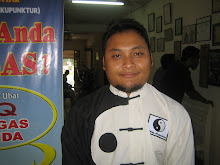

web
http://laser-profnik.blogspot.com
Applications of Laser Acupuncture in Treatment
With the invention of the laser in 1960, skincare experts started using this new technology for treating spots, acne scars and other skin problems. The first low level laser power started to find its application in medical treatment in the 70s. Among other uses, it was applied to replace the metal needles used in traditional acupuncture that had come from China to be practiced in the West. Laser acupuncture started to be used widely in clinical treatment in 1973. Now it is used in the treatment of several health problems like asthma, pneumonia, blood pressure, diabetes and even renal failure etc. There are two type of Acupuncture Laser i.e. 1. Acupuncture laser pens and 2. Laser Radiant Life are becoming more and more popular for those who suffer from carpel tunnel.
You may refer
http://www.homeopathymalaysia.org.my
Laser Acupuncture and Photo-Biostimulation
The mechanism by which laser therapy in acupuncture works is based on the phenomenon of photo-biostimulation i.e. biological changes resulting from stimulation by light. In case of laser therapy, it is laser light that brings about biochemical, electrochemical, and structural changes in the cells of the affected body organ. These changes result in improved functioning of the cells and hence relieve the painful/problematic condition.
Laser Acupuncture in Sinusitis
Sinusitis either causes other respiratory problems or accompanies them. Sinusitis patients who have been treated with acupuncture techniques using laser have been reported as healing better than those who were on drug therapy only. Outwardly, laser did better in relieving the pain of these patients. Tests reveal an increase in the activity of phagocytes (body cells working to increase immunity), increased stimulation of white blood cells (also working to boost immunity), and increase in the amount of lysozyme (bacteria-killing enzyme of the body) in saliva in patients who took laser acupuncture therapy.
Laser Acupuncture in Asthma
Asthma is the problem of some 15 million people in America today. More than six billion dollars are spent on conventional treatment of asthma patients every year. Laser therapy is a cheaper and more effective way of treating asthma and has been experimented with a number of patients. Those who underwent such treatment were reported to have improved function of lungs and better breathing. Acupuncture using laser technology improves the condition of asthma patients in as short a period as ten days. The improvements last from several weeks to several months.
Treating Pneumonia with Laser Therapy
Pneumonia patients who received laser acupuncture treatment showed a notable decrease in the permeability of cell membrane (making it harder for toxic particles to enter cells), increase in the concentration of iron and chromium in the blood, and improvement in microcirculation (important for overall body health). Also, recovery has been more rapid in pneumonia cases that have taken acupuncture therapy with laser treatments.





















